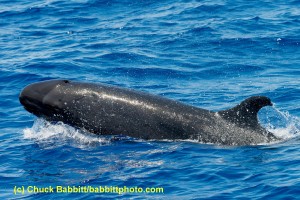Researchers Laud Recovery of Stranded Rare False Killer Whale
Scientists are applauding the efforts of a Hawaiʻi Island resident and an education specialist from the DLNR’s Division of Aquatic Resources for their efforts to transport a 1,300-pound endangered false killer whale from Hawaiʻi Island to Oʻahu in November.
State DLNR officials say that by recovering the whale’s body, researchers were given the opportunity to determine the cause of death, and use the information gathered to help protect the species in the future.
Resident Rodney Kuahiwinui is credited with sighting the dead whale at South Point near Kaʻū and immediately contacting John Kahiapo from DAR.
State officials say that through text messages, which included pictures of the whale, marine mammal experts were able to identify the animal as a highly endangered false killer whale.

Photo credit: © Chuck Babbitt/ babbittphoto.com courtesy Hawaiʻi Dept. of Land and Natural Resources
Kaʻū is one the most remote areas in the state, with many sections that are hard to access. Kuahiwinui, who raises cattle on Hawaiian Home Lands, owns the heavy equipment that was needed to transport the whale.
Using an engine hoist, he was able to lift the animal and place it onto his flatbed truck. With his family, he made the 4 hour journey to Kona where the animal was transported by Transair to Honolulu for examination.
Scientists were able to determine that the adult female, first documented in 2004 and re-sighted eight times near Oʻahu and Hawaiʻi Island, died from abnormal blood clot formations in the heart and lungs.
“Without the unwavering efforts of Rodney and John, we would not have been able to find out why this animal died,” said Dr. Kristi West, head of Hawaiʻi Pacific University’s stranding program. “From my perspective, they really are heroes,” she said.
Only three Hawaiian false killer whales have been reported stranded in the past 18 years. “With less than 200 individuals alive today, every piece of information is critical,” said Dr. West. “If we want to understand the threats facing these animals, we need the public’s help.”
The public is asked to call 1-888-256-9840 or local authorities immediately if they observe a dolphin or whale stranded on the beach or unusually close to shore.
Hawaiʻi Pacific University typically responds to 20 strandings of whales and dolphins per year in the Hawaiian Islands. Approximately 20% of all reported cetacean strandings in the main Hawaiian Islands represent endangered whales, according to the DLNR.
“Today we are fortunate enough to see whales traveling in the area,” said Kuahiwinui in a DLNR press release. “We have to do everything we can to help make sure they are still here for future generations.”
DLNR was recently awarded nearly $1.2 million from the federal government to support the conservation and recovery of Hawai‘i’s endangered false filler whales.











